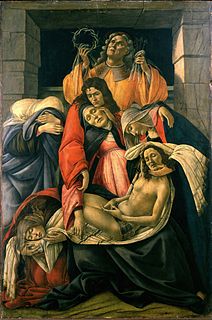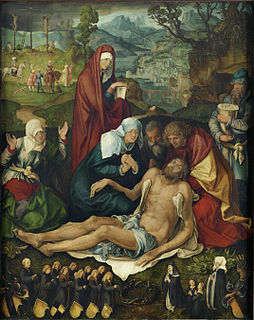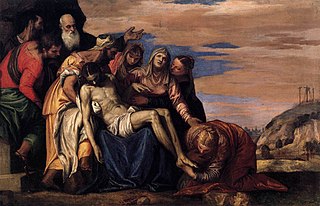
The Book of Lamentations is a collection of poetic laments for the destruction of Jerusalem in 586 BCE. In the Hebrew Bible it appears in the Ketuvim ("Writings"), beside the Song of Songs, Book of Ruth, Ecclesiastes and the Book of Esther, although there is no set order; in the Christian Old Testament it follows the Book of Jeremiah, as the prophet Jeremiah is its traditional author. Jeremiah's authorship is still generally accepted even though authorship isn't specifically notated in the text. According to insight.org "Both Jewish and Christian tradition ascribe authorship to Jeremiah, and the Septuagint—the Greek translation of the Old Testament—even adds a note asserting Jeremiah as the writer of the book. In addition, when the early Christian church father Jerome translated the Bible into Latin, he added a note claiming Jeremiah as the author of Lamentations" It is generally accepted that the destruction of Jerusalem by Babylon in 586 BCE forms the background to the poems.
The Book of Lamentations is part of the Old Testament or Pentateuch.

A lament or lamentation is a passionate expression of grief, often in music, poetry, or song form. The grief is most often born of regret, or mourning. Laments can also be expressed in a verbal manner, where the participant would lament about something they regret or someone they've lost, usually accompanied by wailing, moaning and/or crying. Laments constitute some of the oldest forms of writing and examples are present across human cultures.

Geertgen tot Sint Jans, also known as Geertgen van Haarlem, Gerrit van Haarlem, Gerrit Gerritsz, Gheertgen, Geerrit, Gheerrit, or any other diminutive form of Gerald, was an Early Netherlandish painter from the northern Low Countries in the Holy Roman Empire. No contemporary documentation of his life has been traced, and the earliest published account of his life and work is from 1604, in Karel van Mander's Schilder-boeck.
Esther is the eponymous heroine of the Book of Esther.

The Lament for Ur, or Lamentation over the city of Ur is a Sumerian lament composed around the time of the fall of Ur to the Elamites and the end of the city's third dynasty.
"Ecce homo", is a phrase uttered by Pontius Pilate at the trial of Christ.

A noha, when interpreted in light of Shia views, is a lament about the tragedy of Husayn ibn Ali in the Battle of Karbala.

The Lamentation over the Dead Christ with Saints is a painting of the Lamentation of Christ by the Italian Renaissance artist Sandro Botticelli, dated between 1490–1495. The painting was originally kept in Santa Maria Maggiore, Florence. It is now in the Museo Poldi Pezzoli of Milan. The painting is one of two versions of The Lamentation by Botticelli. The other, circa 1492, is now in the Alte Pinakothek in Munich.

Professional mourning or paid mourning is an occupation that originates from Egyptian, Chinese, Mediterranean and Near Eastern cultures. Professional mourners, also called moirologists and mutes, are compensated to lament or deliver a eulogy and help comfort and entertain the grieving family. Mentioned in the Bible and other religious texts, the occupation is widely invoked and explored in literature, from the Ugaritic epics of early centuries BC to modern poetry.[citation needed] Held in high esteem in some cultures and times, the practice was vilified in others, such as the Chinese Cultural Revolution. Female professional mourners also, called Rudaali, were common in many parts of India, especially in the Western Indian state of Rajasthan.
A lament is a song, poem, or piece of music expressing grief, regret, or mourning.

The Lamentation of Christ is a very common subject in Christian art from the High Middle Ages to the Baroque. After Jesus was crucified, his body was removed from the cross and his friends mourned over his body. This event has been depicted by many different artists.

Lamentation is a fresco painted c.1305 by the Italian artist Giotto as part of his cycle of the Life of Christ on the north interior wall of the Scrovegni Chapel in Padua, Italy.

Lamentation of Christ is an oil-on-panel painting of the common subject of the Lamentation of Christ attributed to German Renaissance artist Albrecht Dürer, executed around 1498 and now in the Germanisches Nationalmuseum of Nuremberg, Germany.

A Mathematician's Lament, often referred to informally as Lockhart's Lament, is a short book on mathematics education by Paul Lockhart, originally a research mathematician at Brown University and U.C. Santa Cruz, and subsequently a math teacher at Saint Ann's School in Brooklyn, New York City for many years. This strongly worded opinion piece is organized into two parts. The first part, "Lamentation", criticizes the way mathematics is typically taught in American schools and argues for an aesthetic, intuitive, and problem-oriented approach to teaching. The second part, "Exultation", gives specific examples of how to teach mathematics as an art.

Lamentation (Pietà) is an oil painting on panel of the common subject of the Lamentation of Christ that is now regarded as by an artist in the "circle" of the Early Netherlandish painter Petrus Christus, rather than by Christus himself. It was painted in c. 1444, and is now in the Louvre in Paris.

Lamentation over the Dead Christ is a c. 1500 tempera on panel painting by Giovanni Bellini kept at the Uffizi Gallery in Florence.

Lament over the Dead Christ is a c.1548 oil on canvas painting by Paolo Veronese, now in the Museo di Castelvecchio in Verona.

The Dead Christ Mourned is an oil painting on canvas of c. 1604 by Annibale Carracci. It was in the Orleans Collection before arriving in Great Britain in 1798. In 1913 it was donated to the National Gallery, London, which describes it as "perhaps the most poignant image in [its] collection of the pietà – the lamentation over the dead Christ following his crucifixion – and one of the greatest expressions of grief in Baroque art".













